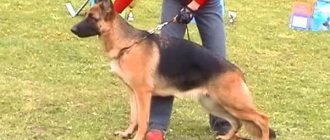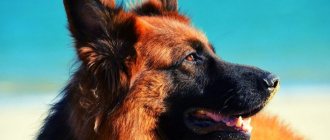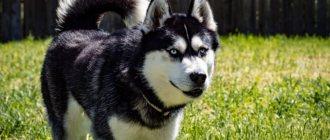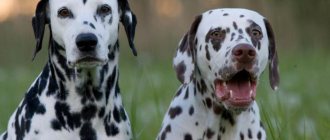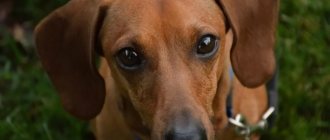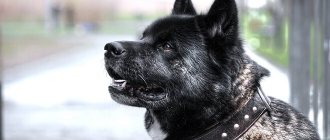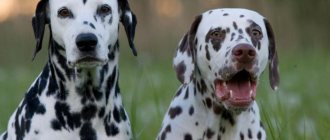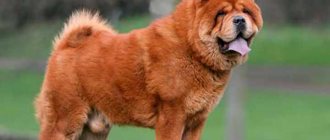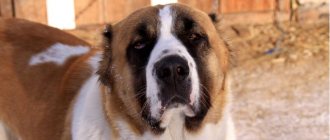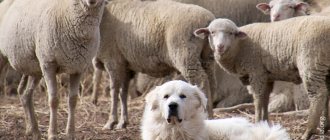The German Shepherd (English: German Shepherd, German: Deutscher Schäferhund) is a dog breed with a relatively short history, having appeared in 1899. Initially intended for shepherd work, over time it became a service-search, guard, guard, protective and simply a human companion. This is one of the most popular breeds in the world, in the USA it ranks second in popularity, in the UK it is fourth.
Theses
- This is an active, intelligent dog. To keep her happy and calm, the owner must exercise her both physically and mentally. Games, learning or work - that's what she needs.
- Regular exercise is required, otherwise the dog will get bored and this will result in negative behavior.
- They are suspicious and distant towards strangers. In order for a dog to grow up calm and confident, it is necessary to carry out early socialization of the puppy. New places, smells, people, sounds, animals will help him in the future.
- These dogs are great for service, but are not recommended for those who are getting a dog for the first time.
- They shed throughout the year, so you need to comb out the dead hair regularly.
- It is advisable to take a training course, this will help you get a controllable dog.
- They perfectly protect their territory and family, but do not forget that without proper socialization and training they can attack random people.
Advantages and disadvantages
Like all breeds, BUTs have pros and cons.
| pros | Minuses |
| Universal | They get excited quickly and love to bark. |
| Attractive appearance | Wool requires special care |
| Easy to learn | A good appetite |
The Shepherd is a good companion, comrade and protector.
This truly versatile dog will make a great family friend. With proper upbringing, she will delight her owners and give them all her love. *Prices are as of November 2022.
History of the breed
German Shepherds are descended from extinct herding dogs that inhabited the territory of modern Germany. During the 18th-19th centuries, cattle breeding was widespread throughout Europe, and Germany was its center. The typical role of the dog at that time was to accompany the herd from point to point and protect it.
Herding dogs of that time were not standardized and were distinguished by great diversity in appearance. After all, they were valued not for their appearance, but for their working qualities.
Often they could not combine the functions of a cattle dog and a guard dog, since the large ones were not smart, and the smart, but small ones could not drive away predators.
The first attempt to correct this situation was made in 1891 by a group of enthusiasts. They created the Phylax Society (from the Greek word Phylax - guardsman), whose goal was to create a standardized German breed by selecting the best representatives.
But disputes over what the breed should look like and which dogs to select led to the collapse of the society just 3 years after its creation. It was officially disbanded in 1894, but became a start for breeding work, as many of its members continued to work on dogs with excellent working qualities and conformation.
One of these members was the cavalryman, Oberleutnant Max Emil Friedrich von Stephanitz (1864 - 1936). He believed that only working qualities and practicality should come first. On duty, von Stefanitz traveled all over Germany and studied various representatives of German dogs.
He noticed that some shepherd dogs could not cope with large sheep and came to the conclusion that it was necessary to breed a medium-sized dog. So that she can cope not only with small and fast sheep, but also with large ones.
As an officer, von Stephanitz graduated from the Veterinary Academy in Berlin, where he gained knowledge of biology, anatomy and physiology, which he applied in creating a new breed. Trying to reach out to everything he could, he began to attend dog shows taking place at that time in Germany.
Gradually, a portrait of the dog he wants to get is formed in his head. For several years, he continues to search for ideal representatives of the breed who can add their own characteristics to this portrait.
In 1898, von Stefanitz received the rank of captain and married an actress. Upon learning of this, the management forces her to resign, since the actress at that time was considered no match for an army officer and was a disrespected profession. And von Stefanitz buys himself a farm, returning to the occupation he always dreamed of - breeding dogs.
In the same year, he attends a dog show in Karlsruhe, where he meets a four-year-old male named Hektor (Hektor Linksrhein). Medium in size, off-white in color, it looked like a primitive dog or even a wolf. But, at the same time, the dog was smart, hardy, and obedient. Reaching approximately 65 cm at the withers, he fit into all von Stephanitz's standards and dreams.
He immediately buys Hector, simultaneously renaming him Horand von Grafrath and coming up with the name of the breed - Deutscher Schäferhund or German Shepherd. In addition, he creates his own club: Verein für Deutsche Schäferhunde (German Shepherd Lovers Club or SV for short). On April 22, 1899, he registered the club and became its first president.
It was Hector, or already Horand von Grafrath, who became the world's first registered German Shepherd. From this point on, all other German breeds are called Altdeutsche Schäferhunde (Old German Shepherd).
Hektor Linksrhein - the first German Shepherd
The SV Club holds the first Sieger Hundeausstellung (today Sieger dog show) in 1899, where a male named Jorg von der Krone and a female named Lisie von Schwenningen win.
In 1900 and 1901, first place was won by a male named Hektor von Schwaben, the son of Hector. This exhibition continues to this day and is the world's largest event for breed lovers.
From the moment the club was founded, von Stefanitz began to shape the image of the breed based on the principle of intelligence and functionality. He always saw shepherds as a working breed, and beauty interested him little. All dogs that could not boast of intelligence, drive, or physical qualities were, in his opinion, useless for humans. He believed that the beauty of a dog lies in its working qualities.
Initially, breeding was based on inbreeding between puppies from Horand von Grafath and his brother Luchs von Grafath. In the early years, Horand was bred to 35 different females, who had 53 litters. Of the puppies born, only 140 were registered as German Shepherds.
Among them were Heinz von Starkenberg, Pilot III and Beowulf, whose dogs are now considered to be the founders of the breed. Although this helped standardize the breed, it gradually led to an increase in recessive genes and hereditary diseases.
To add new blood, von Stephanitz introduces two new males from the main line - Audifax von Grafrath and Adalo von Grafrath. In addition, according to the club's stud book, between the lines SZ#41 and SZ#76 there were several crossings with wolves.
And although such crossing had an effect at that time, recent genetic analyzes have shown that these shepherd dogs have practically no relationship with wolves, wolf blood was dissolved in subsequent lines.
Under the leadership of von Stephanitz, the breed was formed in 10 years, while other breeds required 50 years. That is why he is considered the creator of the modern shepherd dog. The popularity of the breed is growing and he begins to write and distribute leaflets in which he describes the ideal qualities of dogs and what he strives for.
However, it becomes clear that times have changed and industrialization is coming, in which the role of herding dogs is insignificant. Owners are beginning to give preference not to performance qualities, but to the exterior. To combat this trend, von Stephanitz creates a series of tests that every dog must pass before it can be registered.
The beginning of the First World War and anti-German sentiment hit hard on the popularity of shepherd dogs in Europe and the USA.
However, after its completion, it quickly recovers, thanks to the returning soldiers. These soldiers encounter German Shepherds, their loyalty, intelligence and fearlessness and try to bring the puppies home. After the war, there are still serious breeders in Germany who follow the protocol and adhere to the recommendations.
They produce excellent puppies, but at the same time they produce more and more poor quality puppies. Impoverished Germans, inflation and the post-war period have led to the fact that owners want to make money, and they are beginning to actively buy shepherd puppies.
Noticing that the dogs are becoming larger, boxier, and with worse personalities, von Stephanitz and other club members decide to take drastic measures. In 1925, at the Sieger show, Klodo von Boxberg wins.
At the beginning of 1930, a new disaster appeared - Nazism. Concerned about the appearance of the dogs rather than their working qualities, the Nazis take the club into their own hands. Dogs that do not meet their standards are mercilessly destroyed, thus the oldest and rarest representatives of the breed were killed.
Many members of the SV club were Nazis and they pursued their own policies, which von Stephanitz could not influence. They removed him in every possible way and in the end threatened him with a concentration camp. After von Stefanitz gave 36 years of his life to the club, he was suspended and resigned. On April 22, 1936, he died at his home in Dresden. Like the First, the Second World War served the breed. Germany widely used dogs in combat operations and this could not go unnoticed by the Allies. After the end of the war, the dogs were not destroyed, but were actively used and transported around the world. Thus, where other breeds suffered terribly, shepherd dogs only benefited.
True, this led to another change in the breed. It not only changes externally (due to crossing with other breeds), but also functionally. This is no longer a herding dog, but a kind of all-rounder, capable of performing many functions. There is even a so-called American German Shepherd, which differs from the classic body shape.
Today they are one of the most popular breeds in the world, as in the United States they ranked 2nd in popularity in 2010. Intelligent and loyal, these dogs are one of the most widely used working breeds. They serve in the army, police, and customs. They protect, rescue and guard people, search for drugs and explosives.
Interesting Facts
In the ranking of intelligent dogs compiled by scientists from the University of British Columbia, German shepherds are among the leaders.
Thanks to their participation in the First and Second World Wars, shepherd dogs have earned a place in the armed forces of most countries.
The first representative of the breed, a dog named Greif, took part in an exhibition organized in the city of Hanover in 1882.
The city of Togliatti can boast of a monument to a dog that has been waiting for its owners for seven years. The breed of this dog is German Shepherd. The monument is a symbol of love and devotion.
Initially, shepherd dogs were a herding breed. In ancient times, all shepherd dogs that lived in Germany were called shepherd dogs.
Description of the breed
The German Shepherd is very similar in appearance to a wolf or the first, primitive dogs. This is a large, strong, muscular and athletic dog, harmoniously built from the tip of the nose to the tail. Balanced and sensitive, it consists of smooth lines, without sharp or prominent features.
The desired height at the withers for males is 60–65 cm, for females 55–60 cm. Since there is no weight standard for service dogs, it is unlimited. But only a fairly large dog can be called a service dog and usually males weigh 30-40 kg, and females 25-30 kg. There are also much larger representatives of the breed, which sometimes do not fit into any standards.
The head is large, smoothly flows into a wedge-shaped muzzle, without a pronounced stop. The nose is black (exclusively). A distinctive feature of the breed is its pronounced, powerful jaws with a scissor bite. The eyes are almond-shaped, medium in size, the darker the better. The ears are small and not small, pointed.
A double coat of medium length with a thick outer coat consisting of coarse hairs is desirable. The coat can be long or medium in length. The gene responsible for long hair is recessive and long-haired German Shepherds are rare.
Longhaired Shepherds were officially recognized only in 2010, for which the breed standard was changed. Slight waviness is allowed. The hair is shorter on the head, ears, muzzle and paws, and longer and thicker on the tail, neck, and back.
They can be of different colors, but most often they are zoned, saddle-backed or black. Typically there is a black mask on the face. In addition, there are brown (liver or liver), pure white, and blue colors. While all black colors are accepted by most standards, blues and browns may have problems, depending on the organization's standards.
brief information
| ICF classification | 1. Herding and cattle dogs, except Swiss cattle dogs |
| 1. Shepherd dogs | |
| Country of origin | Germany |
| Weight | 22-40 kg |
| Height | 55-65 cm |
| Wool | Wire short or long (smooth or longhair) |
| Color | Black, zoned, black and tan, black |
| Life cycle | 10-14 years |
Character
The breed standard describes the character as follows:
Strong character, direct and fearless, but not hostile. A confident and strong dog, not seeking immediate friendship and distrustful. At the same time, she is sensitive and is ready to serve as a guard, companion, guide for the blind, or shepherd, depending on the circumstances.
In an ideal world, every German Shepherd should be like this. But the popularity of the breed has led to the emergence of a huge number of owners and kennels, often chaotically breeding dogs. And finding an ideal character is quite difficult.
In reality, temperament differs from dog to dog and from line to line. Moreover, he can be both shy and timid, and aggressive, but these are extremes. German working dogs are considered to be more serious, calm and business-like, while American German Shepherds have a wide range of personalities.
Like their characters, they differ from each other in their level of energy. Some are quite excitable and active, others are calmer. But, regardless of this level, every dog should receive regular physical activity: walking, running, playing. This will help her stay in good physical and mental shape.
Shepherds were originally created as an intelligent breed capable of handling a variety of tasks. Stanley Coren, a psychology professor from Canada and author of the book "Canine Intelligence", named German Shepherds as the third smartest dog breed. They are second only to the border collie and the poodle, and even then not to every one.
He notes that on average, a shepherd dog is able to remember simple tasks after 5 repetitions and followed the command 95% of the time. Such a mind needs to be exercised more than the body so that the dog does not get bored and boredom does not result in destructive and negative behavior.
Their natural intelligence and ability to think beyond the average dog means the purebred Shepherd is one of the most capable and trainable dogs of our time. The downside is that they can also use their intelligence against their owners.
For inexperienced owners, a Shepherd's bad behavior can become a problem, especially if they view it as a human, thereby reinforcing the negative behavior. For beginners in cynology, German Shepherds are not suitable and it is better to start with other breeds.
It is important to train puppies to obedience as early as possible, this will not only help control the dog, but will also establish the right relationship between dog and owner. It is best to seek the help of specialists and take training courses, for example, a controlled city dog or a general training course.
Don't forget that no matter how much you love your dog, he should always see you as the alpha, the leader of the pack and take a place one step below. That is why it is preferable to get a dog for those who have experience managing other breeds. The dog owner must be a confident, calm person, and an authority figure for the dog.
Then she is happy, obedient and tries to please him. Training her is not difficult, but should be varied and fun. Intelligent by nature, they quickly understand what is wanted from them and become bored if asked to repeat it again and again.
Training should be positive, as Germans do not respond well to rudeness and harsh discipline. Remember that they are extremely loyal, brave and love their owner so much that they will not hesitate to give their life for him.
The second, critically important factor for developing the right character in a dog is socialization. Since they are guards and protectors by nature, you need to introduce the puppy to situations, animals and people.
This will help him grow into a calm, confident dog, without psychological problems. Facing an unfamiliar situation will not unsettle her; she will react to it adequately.
German Shepherds are known for being aggressive towards other dogs, especially those of the opposite sex. Socialization and raising puppies in the company of other dogs reduces this problem.
However, you should not bring an adult German into the house if there is a same-sex dog living in it, as problems are very likely. They can also chase and kill small animals: cats, rabbits, ferrets. Keep this in mind when walking around the city. At the same time, being raised in the same house with a cat, they calmly treat it, perceiving it as a member of the pack.
They are very territorial and act aggressively if someone enters their territory, no matter if it is a person or an animal. This is especially important to remember for owners of private houses who are responsible for the behavior of their dog even when they are not at home. Unfortunately, most owners who buy a dog to protect their home think that they need a dominant and aggressive breed. And the German Shepherd naturally has the instinct to protect its home and pack, but at the same time it is moderately aggressive.
Puppies usually begin to exhibit this behavior at 6 months of age, barking at strangers. For a large, strong dog, a few sounds are usually enough to cause most strangers to lose interest in the house.
If this does not stop strangers, then the dog acts according to the situation, but never retreats. If you are seriously concerned about the safety of your family and want to raise your dog properly, then spare no expense and complete a full training course.
An experienced trainer will help you raise a dog that will always protect you and your child, but at the same time will not tear to shreds a person who accidentally walks in.
In the family circle, Germans are loyal and calm creatures, they especially love children. However, remember that some dogs are bred by no one knows who or how, and have different personalities. Trainers familiar with the breed usually recognize nervous or aggressive dogs that are prone to fear.
Before you bring such a large, strong and potentially aggressive dog into your home, carefully study its documents, talk with the breeder, owners, and observe its behavior. Character is an inherited trait that largely depends on genetics.
Don’t skimp and go to a trusted nursery so you don’t regret it later. But, even if you have chosen a dog and are confident in it, remember that the games of a small child and a large dog can be dangerous. Teach your child to respect the dog so that he does not feel in a position where he needs to act aggressively.
Despite the fact that some of what is written above may seem scary or overly cautious to you, it is better to be on the safe side, since you don’t know what kind of dog you will end up with. But still, most purebred shepherd dogs are wonderful friends, loving and faithful. Only human greed and stupidity creates dogs with bad character. But which type you choose depends entirely on your decision and desire to find a good dog that suits you. If with other breeds everything is simpler, then you need to approach it wisely, since one line can differ significantly from another in terms of character properties.
Care
Since they have a double coat and a long, stiff outer coat, a little grooming and brushing is necessary. Especially if you are going to keep it in an apartment. However, it is not complicated.
It is enough to brush your dog twice a week to keep it in good shape. German Shepherds shed heavily but evenly throughout the year. In addition, they are clean and take care of themselves.
Breeding German Shepherds
In females of this breed, the first heat occurs at 8–10 months. It lasts about 20–22 days. However, a female can only be allowed to mate for the first time at 20–25 months. A suitable male dog should be found 2 weeks before. It is advisable to draw up a written agreement and visit a veterinarian to rule out bacterial infections in the future parents.
The 13th–15th day of estrus is considered the most favorable for mating. During this time, the bitch is brought to the dog’s house. They may need help.
Repeated mating is carried out after 2 days. Pregnancy lasts 61–65 days. There are 8–10 puppies in a litter.
Health
Although the average lifespan is about 10 years (normal for a dog of this size), they are known for a high number of congenital health problems. The popularity of the breed and its fame had a bad influence on genetics. As with personality, they can differ significantly from one another depending on the line.
Since for some shepherd breeders they are nothing more than income, they have one task - to sell as many puppies as possible. Do you need a physically and psychologically healthy puppy? Go to a trusted (and not cheap) breeder, but choose carefully there too.
Most often they suffer from dysplasia, a hereditary disease that affects the joints, leading to pain and arthritis. A study conducted by the University of Zurich showed that 45% of German Shepherd police dogs have some kind of joint problems.
And a study by the Orthopedic Foundation for Animals found that 19.1% suffer from hip dysplasia. In addition, they are more likely than other breeds to have diseases such as degenerative myelopathy, von Willebrand disease, and chronic kidney damage.
How to choose?
When choosing a German Shepherd, cynologists recommend adhering to several rules.:
- choose a place to take the puppy. It is not worth buying on the market; most often the sellers do not have documents, or they are fake. It is better to take puppies from kennels where dogs are bred according to mating rules;
- look at all the dogs in the litter, not just one. If they are all active and healthy, eat properly and are not afraid of people, then you can adopt a puppy;
- take a closer look at the animal, take it in your hands. It would be a good idea to pay attention to the weight; for a one-month-old puppy it should be from two to four kilograms;
- don't be afraid to ask questions. It is worth finding out the pedigree of the animal and viewing supporting documents.
Every German Shepherd has good potential, for the development of which you need to systematically work with your pet..
Proper upbringing will make him a loyal friend and helper for the whole family. However, remember that before purchasing you should weigh all the pros and cons, because any animal is not only a joy, but also a great responsibility.
